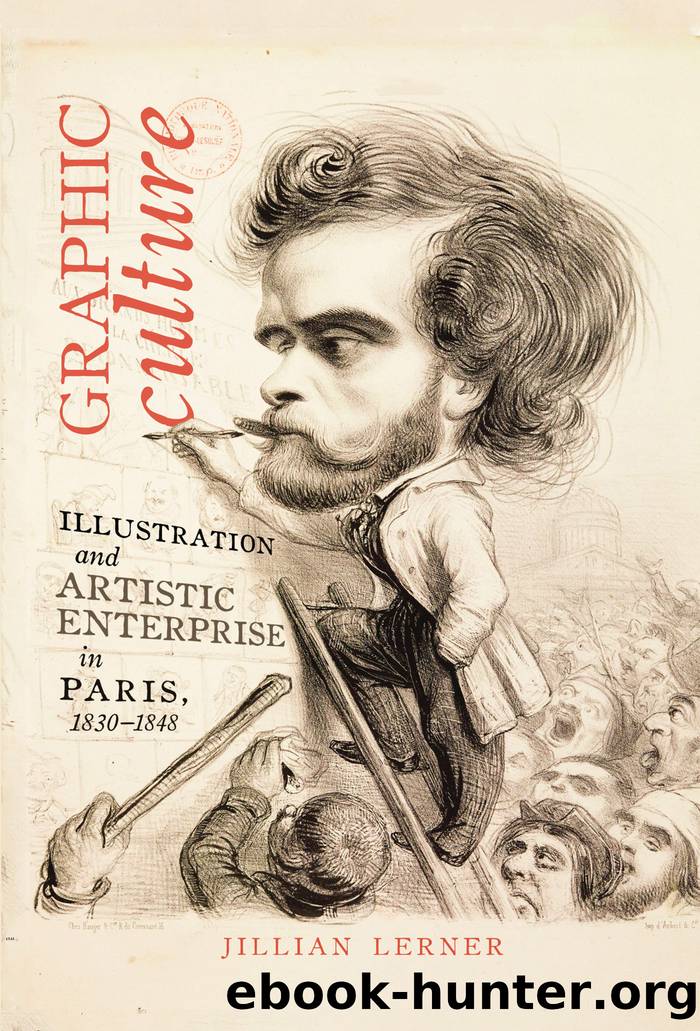Graphic Culture by Lerner Jillian;

Author:Lerner, Jillian;
Language: eng
Format: epub
Publisher: McGill-Queen's University Press
Published: 2018-05-15T00:00:00+00:00
Gavarniâs Costumes
Masquerade and the Social Theatres of Paris
Although Gavarni is best known as a caricaturist and fashion illustrator, he was also a sought-after costume designer for Parisian theatre productions and carnival celebrations. In fact, he played a key role in the renovation of masked balls and masquerade costumes in the 1830s and 1840s. His costume work forged vital links between the theatre, print culture, and the social practices of ordinary Parisians. This was a time when Parisian artists and actresses became important public figures, prototypical media stars whose participation in urban life was increasingly performative and culturally authoritative. Several July Monarchy entrepreneurs explored how to leverage this artistic celebrity as a form of publicity.
Here two aspects of Gavarniâs activity as a theatrical costumier are analyzed: his invention of the débardeur, a travestied stevedore costume, and his collaboration with Virginie Déjazet (1798â1875), an actress famous for racy cross-dressing roles. Gavarniâs prints added significance to Déjazetâs roles on stage, and Déjazetâs performances were instrumental in popularizing Gavarniâs débardeur. A revealing case of artistic cross-promotion, the history of this transgressive costume also indicates the expansion of gender roles and alternative lifestyles during the July Monarchy.
Masquerade was much more than a form of amusement in nineteenth-century Paris. Among other things, it was a means to understand and experience the shape-shifting potential of modern life. Several aspects of the new society taking shape in post-revolutionary France could be made legible through the vocabulary of carnival, travesty, and performance. Carnivalesque inversion and the well-worn image of the world as a stage were particularly resonant tropes in this era of upheaval, when traditional social hierarchies had been overturned and there was heightened consciousness about the mutable nature of identity. Participants in the newly renovated social theatres of Paris â understood as both a historical and a metaphorical horizon â had much to gain by seeking out new scripts, roles, and interpretive guides. Gavarni and Déjazet were among the artists keen to adapt their services and try out for a part. They both became known as specialists in travesty, a word that in both French and English slides from clothing and disguise to grotesque imitation and perversion: its means include costume, caricature, pantomime, parody, farce, and the subversion of social norms.
This chapter begins with an introduction to the evolving attractions of the Paris Opera, including the new prominence of female performers, masked balls, and participatory experiences for theatre-goers. It then traces the development of Gavarniâs expertise in costume design and his role in the revival of carnival balls in the 1830s and 1840s. The concluding section examines the débardeur costume and its migration from the artistâs studio to the interconnected spaces of print, the stage, and social practice. Issues to be explored throughout include cross-platform mobility; the social work of travesty in revising gender, sexuality, and class; the blurring of distinctions between performers and spectators; and the passages between social representations and reality.
Download
This site does not store any files on its server. We only index and link to content provided by other sites. Please contact the content providers to delete copyright contents if any and email us, we'll remove relevant links or contents immediately.
Technical Art History by Jehane Ragai(443)
Art, Science, and the Natural World in the Ancient Mediterranean, 300 BC to AD 100 by JOSHUA J. THOMAS(398)
Graphic Culture by Lerner Jillian;(390)
The Slavic Myths by Noah Charney(360)
Pollak's Arm by Hans von Trotha(331)
Simply Artificial Intelligence by Dorling Kindersley(328)
Treasuring the Gaze by Hanneke Grootenboer(328)
The Art of Portrait Drawing by Cuong i(324)
Sketchbook Confidential: Secrets from the private sketches of over 40 master artists by Editors of North Light Books(323)
Drawing for the Soul by Zoë Ingram(318)
Drawing Landscapes by Barrington Barber(310)
The Art of Painting Sea Life in Watercolor by Maury Aaseng Hailey E. Herrera Louise De Masi and Ronald Pratt(299)
Mountain Manâs Field Guide to Grammar by Gary Spina(298)
Portrait of a Woman by Bridget Quinn(287)
A text-book of the history of painting by Van Dyke John Charles 1856-1932(278)
Anatomy for the Artist by Jennifer Crouch(277)
Preparing Dinosaurs by Wylie Caitlin Donahue;(274)
Botanical Illustration by Valerie Price(269)
Egyptian art by Jean Capart(266)
